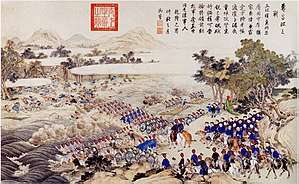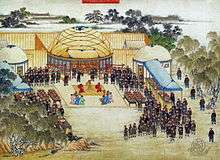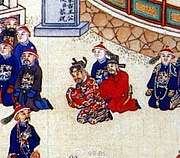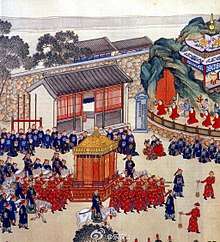Battle of Ngọc Hồi-Đống Đa
| Qing invasion of Vietnam | |||||||
|---|---|---|---|---|---|---|---|
 Fuk'anggan and Sun Shiyi defeated the Vietnamese at Thọ Xương's river in 1788 | |||||||
| |||||||
| Belligerents | |||||||
|
Lê dynasty | Tây Sơn dynasty | ||||||
| Commanders and leaders | |||||||
|
Lê Chiêu Thống Hoàng Phùng Nghĩa |
Nguyễn Huệ Phan Văn Lân Ngô Văn Sở Nguyễn Tăng Long Đặng Xuân Bảo Nguyễn Văn Lộc Nguyễn Văn Tuyết Đặng Tiến Đông Phan Khải Đức Nguyễn Văn Diễm Nguyễn Văn Hòa | ||||||
| Strength | |||||||
|
20,000 Lê dynasty supporters Qing records mentioned 15,000 Qing troops (including porters) The Chronicle of Greater Vietnam mentioned 200,000–290,000 Qing troops | 100,000 (50,000 regulars, 20,000 newly recruited militia) | ||||||
| Casualties and losses | |||||||
|
30,000 killed 3,400 captured | 8,000+ | ||||||
Battle of Ngọc Hồi-Đống Đa (Vietnamese: Trận Ngọc Hồi - Đống Đa; Chinese: 清軍入越戰爭) was fought between the Tây Sơn dynasty of Vietnam and the Qing dynasty of China in Ngọc Hồi and Đống Đa in northern Vietnam from 1788 to 1789. It is considered one of the greatest victories in Vietnamese military history.[1]
Background
For most of the history, Vietnamese emperors sometimes recognized the Chinese Emperor as their feudal lord, while ruling independently in their own land. This had been the case throughout the reign of the Later Lê dynasty.

.jpg)
However, the Tây Sơn uprising broke out in 1771, and the Lê dynasty was overthrown by the Tây Sơn army in 1787. The last emperor, Lê Chiêu Thống, fled to China and appealed to the Qianlong Emperor of the Qing Empire for help. In 1788, a large Qing army was sent to Vietnam, in order to restore Lê Chiêu Thống to the throne.
Battle
Sun Shiyi, the Qing Viceroy of Liangguang, was appointed as commander in chief. According to Draft History of Qing, the total number of Qing troops was about 200,000-290,000 (Qing records mentioned 15,000 troops, including soldiers and porters) which were recruited from Guangdong, Guangxi, Yunnan and Guizhou provinces.

In October, the Qing armies began their invasion. On November 19, Thăng Long (modern Hanoi) was captured by Qing forces. The Vietnamese retreated to Tam Điệp mountains; from there they sent a messenger to Phú Xuân (modern Huế), appealing to Nguyễn Huệ for help.
Nguyễn Huệ was proclaimed the Quang Trung Emperor, and recruited 100,000 volunteers in Nghệ An Province. Then he gathered his forces in the countryside around Thăng Long which had been taken by the Qing forces. He launched a surprise attack against the Qing forces while they were celebrating the Chinese New Year festival of the year 1789. Most of Chinese soldiers were unprepared, so were disastrously defeated by the Tây Sơn army in Ngọc Hồi and Đống Đa (part of modern Hanoi). Qing generals Xu Shiheng, Shang Weisheng, Zhang Chaolong and Cen Yidong were killed in action. Xu Shiheng was a Hui Muslim. Nguyễn Huệ recaptured Thăng Long, and Sun Shiyi and Lê Chiêu Tông fled back to China. Many Qing soldiers and porters drowned while crossing the Red River.
Aftermath
Although the Tây Sơn under Nguyễn Huệ won this battle, he eventually submitted himself as vassal of the Qing Empire and agreed to pay tribute annually. Battle of Ngọc Hồi-Đống Đa was considered one of the greatest military victories by Vietnamese people, but was also considered one of "Ten Great Campaigns" during the reign of the Qianlong Emperor by the Chinese.


The pro Chinese Nguyễn lords eventually defeated the Tây Sơn dynasty and took complete control of Vietnam when they established the Nguyễn dynasty.
Due to a Tay Son massacre against ethnic Chinese, the Nguyen were supported by ethnic Chinese against the Tay Son.[2] The Tay Son's downfall and defeat at the hands of Nguyễn Phúc Ánh was due to ethnic Chinese support to the Nguyen.[3]
Cultural influence
The Vietnamese victory was seen as the next following step after the Burmese Konbaung Dynasty's heroic victory over the Qing Chinese in the earlier Sino-Burmese War before. While it is registered as one of Vietnam's greatest military victory, the Vietnamese victory also put a stunning strike, preventing the other attempts of Qing invasion to occupy Southeast Asia. However, due to less significant, it is not known. However, in Vietnam, there are several commemorations of Emperor Quang Trung who helped to defeat the Qing and defended independent Vietnamese state.
See also
| Wikimedia Commons has media related to Battle of Ngọc Hồi-Đống Đa. |
References
- ↑ Spencer TuckerVietnam Page 20 1999 "Quang Trung promised to treat humanely all Chinese who surrendered and many did so.53 The Vietnamese know this series of victories as the Victory of Ngọc Hồi-Đống Đa, the Emperor Quang Trung's Victory over the Manchu, or the Victory of Spring 1789. It is still celebrated as the greatest military achievement in modern Vietnamese ..."
- ↑ Choi Byung Wook (2004). Southern Vietnam Under the Reign of Minh Mạng (1820-1841): Central Policies and Local Response. SEAP Publications. pp. 35–37. ISBN 978-0-87727-138-3.
- ↑ Choi Byung Wook (2004). Southern Vietnam Under the Reign of Minh Mạng (1820-1841): Central Policies and Local Response. SEAP Publications. pp. 74–. ISBN 978-0-87727-138-3.